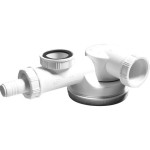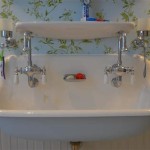How To Clean Tall Bathroom Mirrors
Tall bathroom mirrors, extending from the vanity to the ceiling or spanning across a significant portion of the wall, offer a visually appealing and functional element to any bathroom. However, due to their size and location, they are particularly susceptible to accumulating streaks, water spots, hairspray residue, and toothpaste splatters. Maintaining a streak-free and sparkling clean tall bathroom mirror requires a systematic approach and appropriate cleaning techniques.
The difficulty in cleaning tall bathroom mirrors often stems from the inaccessibility of the upper portions of the mirror. Without the right tools and methods, achieving a thorough and even clean can be challenging, leading to frustration and unsatisfactory results. This article provides a detailed guide on effectively cleaning tall bathroom mirrors, outlining essential tools, cleaning solutions, and techniques to ensure a pristine reflection.
Preparation and Essential Tools
Before embarking on the cleaning process, gathering the necessary tools and preparing the area is crucial. This preparatory step streamlines the cleaning process and ensures a more efficient and effective outcome. A well-prepared workspace also minimizes potential damage to surrounding fixtures and surfaces.
Essential tools for cleaning tall bathroom mirrors include:
*Microfiber Cloths:
These are indispensable for achieving a streak-free finish. Microfiber cloths are highly absorbent and effectively lift dirt and grime without leaving lint or streaks. It is recommended to have at least two microfiber cloths: one for cleaning and one for drying/polishing. *Spray Bottle:
A spray bottle is necessary for applying the cleaning solution evenly across the mirror surface. A bottle with an adjustable nozzle allows for controlling the spray pattern and minimizing overspray. *Cleaning Solution:
The choice of cleaning solution depends on the type of grime and residue present on the mirror. Options range from commercial glass cleaners to homemade solutions. *Extension Handle (Optional):
For particularly tall mirrors, an extension handle that can be attached to a microfiber cloth or squeegee is invaluable for reaching the upper portions without straining or risking falls. *Squeegee (Optional):
A squeegee can be used to remove excess cleaning solution, further minimizing streaks and water spots. Opt for a squeegee with a flexible rubber blade for optimal contact with the mirror surface. *Ladder or Step Stool (If Necessary):
If the mirror extends significantly high, a stable ladder or step stool may be necessary to safely reach the upper portions. Ensure the ladder or step stool is placed on a level surface and is in good working condition. *Protective Covering (Optional):
To prevent cleaning solution from dripping onto the vanity or floor, consider placing a towel or plastic sheet beneath the mirror. *Warm Water:
Access to warm water is useful for rinsing cloths and diluting cleaning solutions, if required.Once all the necessary tools are gathered, the surrounding area should be cleared of any obstructions. This includes removing items from the vanity countertop and ensuring adequate ventilation by opening a window or turning on the exhaust fan.
Choosing the Right Cleaning Solution
The selection of the appropriate cleaning solution is critical for achieving a clean and streak-free mirror without causing damage. Several options are available, ranging from commercial glass cleaners to homemade solutions. The choice depends on personal preference, the severity of the grime, and environmental considerations.
Commercial Glass Cleaners:
These are readily available and designed specifically for cleaning glass surfaces. They typically contain solvents and detergents that effectively remove dirt, grime, and smudges. When using commercial glass cleaners, follow the manufacturer's instructions carefully and avoid excessive spraying, which can lead to streaking.Vinegar and Water Solution:
A diluted vinegar solution is a natural and effective alternative to commercial glass cleaners. The acidity of vinegar helps to dissolve soap scum and hard water stains. A common ratio is one part white vinegar to one part water. This solution is safe for most mirror surfaces and is environmentally friendly.Rubbing Alcohol and Water Solution:
Similar to vinegar, rubbing alcohol is an effective solvent that can dissolve grime and leave a streak-free finish. A solution of one part rubbing alcohol to one part water is suitable for cleaning mirrors. Be cautious when using rubbing alcohol near painted surfaces, as it can potentially damage the finish.Dish Soap and Water Solution:
A mild solution of dish soap and water can be used to remove stubborn grime and oily residues. Use only a small amount of dish soap, as excessive soap can leave a film on the mirror. Thoroughly rinse the mirror with clean water after cleaning with dish soap.Ammonia-Based Cleaners (Use with Caution):
While ammonia-based cleaners are effective at removing stubborn grime, they should be used with caution. Ammonia can be irritating to the eyes and respiratory system, so ensure adequate ventilation when using these cleaners. Avoid mixing ammonia-based cleaners with bleach, as this can create toxic fumes. Additionally, ammonia can damage certain mirror coatings, so test the cleaner on an inconspicuous area before applying it to the entire mirror surface.Regardless of the chosen cleaning solution, it is essential to test it on a small, inconspicuous area of the mirror before applying it to the entire surface. This ensures that the solution does not damage or discolor the mirror's reflective coating.
Cleaning Techniques for a Streak-Free Finish
The cleaning technique employed is equally important as the choice of cleaning solution. Using the correct technique will minimize streaks and water spots, resulting in a sparkling clean mirror.
Step 1: Dusting the Mirror:
Before applying any cleaning solution, remove loose dust and debris from the mirror surface. This can be done using a dry microfiber cloth or a duster. Removing the dust beforehand prevents it from being smeared across the mirror during the cleaning process.Step 2: Applying the Cleaning Solution:
Pour the selected cleaning solution into a spray bottle. Lightly spray the solution onto the mirror surface, ensuring even coverage. Avoid overspraying, as this can lead to drips and streaks. If using a homemade solution, ensure it is thoroughly mixed before spraying.Step 3: Cleaning the Mirror Surface:
Using a clean microfiber cloth, wipe the mirror surface in a systematic manner. Start at the top of the mirror and work your way down, overlapping each stroke slightly. Use a gentle, circular motion to loosen and remove dirt and grime. If using an extension handle, ensure it is securely attached to the microfiber cloth or squeegee. For particularly stubborn grime, allow the cleaning solution to dwell on the affected area for a few minutes before wiping.Step 4: Drying and Polishing:
After cleaning the mirror surface, use a clean, dry microfiber cloth to dry and polish the mirror. Again, start at the top and work your way down, overlapping each stroke. Apply gentle pressure to remove any remaining moisture and buff the surface to a streak-free shine. Alternatively, use a squeegee to remove excess cleaning solution. Overlap each stroke of the squeegee and wipe the blade clean after each pass.Step 5: Inspecting the Mirror:
After drying and polishing, carefully inspect the mirror for any remaining streaks or water spots. If any are found, lightly dampen a clean microfiber cloth with the cleaning solution and re-wipe the affected area. Dry and polish again until the mirror is completely streak-free.Additional Tips for Stubborn Stains:
*Hairspray Residue:
Hairspray residue can be difficult to remove. Try using a solution of rubbing alcohol and water, or a dedicated hairspray remover. *Toothpaste Splatters:
Toothpaste splatters can be removed by gently scrubbing with a soft-bristled toothbrush and a mixture of baking soda and water. Rinse thoroughly with clean water. *Hard Water Stains:
Hard water stains can be dissolved using a solution of white vinegar and water. Allow the solution to dwell on the affected area for a few minutes before wiping.Regular cleaning, ideally on a weekly or bi-weekly basis, will help to prevent the buildup of grime and make the cleaning process easier. Proper cleaning techniques and the use of high-quality microfiber cloths are essential for achieving a streak-free and sparkling clean tall bathroom mirror.

How To Clean A Mirror Like Professional Cleaner

Perfectly Clean My Large Tall Mirror

How To Clean Mirrors Without Streaks In Under 5 Minutes Love Our Real Life

Cleaning Using A Swiffer To Clean Your Mirror

How To Clean A Mirror Like Professional Cleaner

How To Clean Water Stains From Bathroom Mirror

How To Clean Bathroom Mirrors Without Streaks By Mira Showers

How To Clean A Mirror Streak Free Tips Tools Ycs

How To Clean Mirrors Without Streaks Poundland

Tall Mirrors Will Make Your Bathroom Grow Glow Here S How Designed
Related Posts






